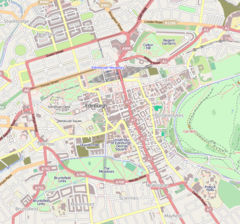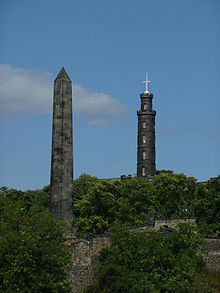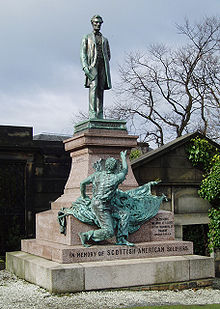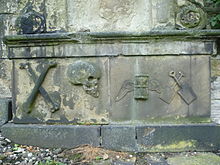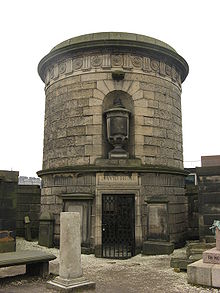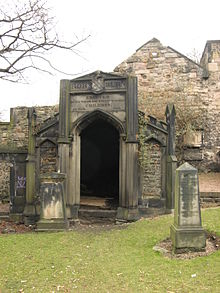- Old Calton Cemetery
-
Old Calton Cemetery 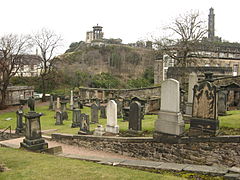
Old Calton Cemetery, looking towards Calton HillDetails Year established 1718 Country Scotland Location Edinburgh Type Public Owned by City of Edinburgh Council Old Calton Cemetery (also called Old Calton Burial Ground) is a graveyard in Edinburgh, Scotland. It is located on Calton Hill, to the north-east of the city centre. The burial ground was opened in 1718, and is the resting place of several notable Edinburgh persons, including philosopher David Hume, publisher William Blackwood and clergyman Dr Robert Candlish. It is also the site of the Political Martyrs' Monument, an obelisk erected to the memory of a number of political reformers. The burial ground was altered following the construction of Waterloo Place in 1819, which divided the graveyard into two sections. Along with Edinburgh's other graveyards, Old Calton is managed by City of Edinburgh Council. The cemetery and its monuments are protected as a category A listed building.[1]
History
The name Calton, according to the more Anglicised opinions, derives from "cold-town", due to its exposed position. This is clearly inaccurate, as the name predates any settlement thereon. It is more logically either Choille-dun (forested hill) or Cauldh-dun (black hill), both ancient Gaelic in origin.
Many old legends belong to the hill, most notably that of The Fairy Boy of Leith, who was said to drum at night on the hill, to provide music for the ancient spirits belonging there. From the earliest times it was a hanging ground for criminals, and these were buried on the hill in pre-consecrated days.
On the north side of the hill, a former hollow (now built over) at Greenside Place, was a natural (if rather steep) amphitheatre, and was a traditional site for jousting, fairs, open air theatre etc. It was the first place of performance for David Lyndsay's 16th century play Ane Pleasant Satyre of the Thrie Estaitis.
In May 1518 the Carmelite Friars (known as White Friars and locally based at South Queensferry), were granted lands by Royal Charter, including Calton Hill, and built a small monastery at its base (roughly where the Calton Road access to Waverley Station is currently). Monasteries were suppressed following the Scottish Reformation of 1560, and this stood empty for 30 years before conversion in 1591 into a hospital for lepers and plague victims. Prior to this date a separate leper colony had existed on the hill, tended by the friars, but these really required a better facility. Numbers had greatly increased in 1568, following an outbreak of plague. Infected persons had to spend 40 days here to be declared clear of the disease. Those 40 evenings give rise to the term quarantine, from Franco-Scots quarant (40) e’en (evenings).[citation needed] The dead were buried in pits at the base of the hill. A gallows connected to the building was erected on Calton Hill, to deal with escapees. This was re-erected within the building enclosure when the hospital was formed. The gallows were also used on condemned witches, including Edinburgh’s self-confessed warlock, Major Thomas Weir.
The lands passed to Lord Balmerino, of Leith, who as feudal laird of the hill, granted them to the Trades of Calton, a craft guild of primarily shoemakers, in 1631. In 1669 Calton was given separate burgh status. It was elevated to a burgh of barony in 1725, which lasted until 1859, when it became officially part of Edinburgh.
In 1718 a burial ground was granted and walled off, remaining in the control of the Trades of Calton until 1788, when Edinburgh Town Council bought it, for wider burial use, and to aid access to the New Town. The area was originally used for purposes other than just burial, and it acted as a village green, bleaching green and grazing area. The village of Calton stood on three sides; north, east and south. The west side was too steep to develop. Only the northern terrace survives, on the street now named Calton Hill.
Edinburgh expanded the graveyard onto the crags to the south and west, but left their projected road alignment clear. The new road, named Waterloo Place after the contemporary victory at Waterloo, was approved in 1814 and built between 1815 and 1819. This road cut through the existing graveyard, requiring major removal of bodies and stones. Unusually for the period this was done with a high degree of decorum, bones being carefully grouped and wrapped for removal to New Calton Cemetery, 0.5 kilometres (0.31 mi) eastwards, where several of the more substantial stones were also re-erected. These transported stones belie the age of that cemetery, as it is odd to find 18th-century stones in a 19th-century cemetery. Due to the cut, a small section of the graveyard is isolated to the north side of Waterloo Place, and is accessed from Calton Hill. The building to its east, also on previously consecrated ground, was built by Edinburgh for the Trades of Calton as a Convening House, in partial compensation for the disruption of their loved ones.
The landscape was changed further in 1796 when the workers houses on the east side of the cemetery were demolished to build the Bridewell (debtor’s prison), of which only the governor’s house (1816) survives. Its remnant lower walls are still visible when viewing St Andrew's House from the south. The City Gaol (1815) was wholly obliterated by St Andrew's House when it was built.
In the 18th century, a wealthy Jew, not entitled to burial in Christian churchyards, reportedly paid 700 guineas to the Town Council to be interred on Calton Hill. As a result Jacob Isaac and his wife were interred in a small cave on the hill. Little evidence supported this story until 1990, when a visitor to the old observatory on Calton Hill spotted a large hole, and on investigation found the tomb.[2]
Monuments and burials
Martyr's Monument
Main article: Political Martyrs' MonumentIn 1793 several members of The Friends of the People, an early universal suffrage movement, were brought to trial and deported, being charged with treason for attempting to correspond with the French. Their true crime in the eyes of the judges was to push for universal suffrage, and the rights of the common man to control his destiny, i.e. voting rights for all, not just landowners. The men became known as the Chartist Martyrs. Thomas Muir of Hunter’s Hill was their leading figure, and he, along with four others who followed him, was banished to Botany Bay in Australia on 30 August 1793. The men went on to become prosperous citizens in that country.
The huge obelisk, clearly visible from many central Edinburgh viewpoints, is the focal point of Old Calton Cemetery, and was erected in their memory. The choice of this site is probably linked to the graveyards lack of affiliation to any church, and prominent position. There is no known connection between any of the martyrs and Calton parish. The inscription reads:
To the memory of Thomas Muir, Thomas Fyshe-Palmer, William Skirving, Maurice Margarot, and Joseph Gerrald, erected by the Friends of Parliamentary Reform in England and Scotland 1844.I have devoted myself to the cause of the people, it is a good cause – it shall ultimately prevail – it shall finally triumph – speech of Thomas Muir in the Court of Justiciary on the 30th August 1793.
I know that what has been done these two days will be re-judged – speech of William Skirving on the 7th January 1794.The Scottish Reform Act 1832 eventually brought about their aim, and the men were pardoned in 1838, but were not given their passage home so most stayed in Australia, and died there. The monument was erected some 50 years after their stand, but was inspired by the Reform Act brought about by their original actions.
Scottish – American Soldiers Monument
A focal point of the graveyard, just in front of Hume’s tomb, this piece of statuary was erected in 1893. It depicts a standing figure of Abraham Lincoln, with a freed slave giving thanks at his feet. A bronze shield bears the old US flag, and is wreathed in thistles to the left, and cotton to the right. Two regimental flags lay furled, the battle being over. The black man holds a book, indicating that he is not only free, he is also now educated. This was the first statue to an American President in any country outwith the USA. It is the only statue of Lincoln in Scotland, and the only monument to the American Civil War outwith the USA. The monument was erected at American expense to a small group of Scots (only one of whom, William Duff, is buried under the monument, the rest being nearby) to whom it felt indebted, and wished their graves to be marked, despite their later poverty. They had all fought for the Union (the North) in the American Civil War. The inscription, "To preserve the jewel of liberty in the framework of Freedom" is a quotation from the writings of Abraham Lincoln.
Those interred and commemorated are:
- Sergeant Major John McEwan, Co H 65th Regt Illinois Yol Infantry
- William L Duff, Lt Col 2nd Illinois Regt of Artillery (died of wounds on return to Edinburgh)
- Robert Steedman, Co E 5th Regt Maine Infantry Volunteers
- James Wilkie, Co C 1st Michigan Cavalry
- Robert Ferguson, Co F 57th Regt New York Infantry Volunteers
- Alexander Smith, Co G 66th Regt New York Infantry Volunteers. (This name was added in 1993 following research)
The following appears in the Town Council records
Act of Council 32, Edinburgh 1st Sept 1892 The Magistrates and Council having on a letter from the United States Consul (Mr Wallace Bruce) of 25 July 1892. Signified their approval of a proposal made by him that a burying place should be provided for certain old pensioned American soldiers in the Old Calton burying ground, the Plans and Works Committee acting under remit with powers, beg to report that they have fixed, as a site, a piece of ground 14 feet by 14 feet or thereby, in the Old Calton Burial Ground about 16 feet or thereby north of David Hume’s monument.[3]It was the widow of Sgt Major MacEwan who originally initiated the request by writing a letter of complaint to the United States government.
Tradesmen's monuments
A number of 18th-century monuments to local tradesmen are interesting for their detailed carving. The largest and most elaborate of these is that of John Morton, heelmaker, who died in 1728, aged 54. Although a long inscription is given, the stone is more notable for its form and decoration. It has a portico-style frame, with a pediment bearing a crest with two lions rampant. Two carved female figures flank the monument, exposing their breasts and holding a book open to view.
Another stone, dated 1762, bears a skull and the motto "Memento Mori", with an hourglass lying on its side, indicating the sands of life not fully run, an early death, as well as crossed bones and crossed shovel and spade, signifying decay and burial, and insignia of a master shoemaker. It is inscribed "Here lyes Margrat Thomson, spous to James Forsyth, shoemecker in Calton. She died Apl 30th 1760 and aged 43 years & allso 8th of her children".
David Allan
Even from an early age, the painter David Allan (1744–1796) showed artistic talent, being expelled from school for caricaturing a master. Known as "the Scottish Hogarth", he illustrated The Gentle Shepherd by Allan Ramsay and importantly much of Robert Burns' work. His grave was originally unmarked. The headstone was erected in 1874, almost 80 years after his death, by the Royal Scottish Academy, and includes a profile medallion insert of his likeness.
David Hume
Historian and philosopher David Hume (1711–1776), author of Treatise of Human Nature, was a household name across Europe in the 18th century, and a critical figure in the Scottish Enlightenment. He was a strong influence on many other thinkers and public figures, Adam Smith among them. However, his grave had to be guarded for 8 days after burial, due to strong public hostility towards him at the time of his death, largely due to his professed atheism.
In his will Hume requested that a "Monument be built over my body ... with an Inscription containing only my Name and the Year of my Birth and Death, leaving it to Posterity to add the Rest." [4] The tomb is a large cylindrical tower on the Edinburgh skyline. It was designed by Robert Adam in 1777. Whilst Hume was not religious, leading to be buried in this non-denominational site, other family members did not hold his views. His niece is also interred here and she added a particularly Christian sentiment to her panel, which reads "Behold, I come quickly, thanks be to God which giveth us the victory through our Lord Jesus Christ".
Hume's home, between 1771 and 1776, was relatively close by, on the corner of St David Street and St Andrew Square, but that location has never been visible from Hume's tomb (as some claim).
John Gray's stone
The very well-carved stone erected by Captain John Gray in memory of his parents, c.1760, is in excellent condition, and is arguably the most interesting in the whole burial ground. It is inscribed with his name and then a carved anchor, beneath which is a carving of a 3-masted ship, flying the ensign, shown in bold relief. Down the left side of the stone is a skull and bearded, male head wearing a cap (his father). From the mouth spill two ribbons, that link symbols of death: a scythe crossed with another implement (not recognisable) and crossed bones. Down the right side is a female head, wearing a bonnet (his mother). Ribbons from the bonnet link again to symbols of death: a spade crossed with a coffin, and again crossed bones (specifically thigh bones).
James Leishman McDougal VC
This very recently erected stone commemorates James Leishman McDougal (1840–1869), a soldier awarded the Victoria Cross for his infiltration of Taku Forts during the Second China War. The medal was later stolen from his home and its whereabouts are unknown.
Charles Mackay
Charles Mackay (d.1857), comedian and actor, was particularly distinguished in his portrayal of the character of Baillie Nicol Jarvie, and other characters of Walter Scott's invention. Mackay is allegedly the figure referred to in the phrase "the real McCoy".
William Woods
From about 1772 to 1802 William Woods was the favourite and leading actor on the Edinburgh stage. The main marble tablet is eroded and illegible, a new inscription has been added to the rear, which reads "Re-erected 1865 by a few gentlemen who thought it well that the last resting place should not be forgotten of one who contributed largely to the enjoyments of his fellow creatures and whose taste and talents recommended him to the friendship of the poets, Fergusson and Burns".
Life’s but a walking shadow – a poor player that struts and frets his hour upon the stage and then is heard no more. William Shakespeare, Macbeth, V, v.Pity it is that the momentary beauties flowing from an harmonious elocution cannot, like those of poetry, be their own record, that the animated graces of the player can live no longer than the instant breath and motion that presents them or at best can faintly glimmer through the memory of imperfect attestation of a few surviving spectators. Colley Cibber, Shakespeare in the Theatre.John Haig
The Scots distiller John Haig is buried here, together with several members of the Haig whisky family. Haig is of most note for being instrumental in the enterprising promotion of whisky at the failure of the wine and brandy market in the late 19th century. As part of this venture he effectively invented blended whisky and turned whisky in Scotland into a true industry rather than a practice simply supplying local needs. The family business later became United Distillers. John Haig was the father of Field Marshal Lord Douglas Haig, of World War One fame. The latter does not lie in this family vault but is buried at Dryburgh Abbey.
Dr Robert Candlish
Dr Robert Candlish (1806–1873) was a clergyman and leader of the Disruption of the Scottish Church in 1843, when 470 ministers rose during the General Assembly, and left never to return due to growing differences of opinion on how the church was practicing. Together with Rev. Thomas Chalmers he set up the Free Church of Scotland. Dr Candlish was previously minister of St George's Parish Church. He was a fervent author of religious books, and became Moderator of the Free Church in 1861. The Free Churches lost their right to burial in the parish churchyards due to the split. Most new churches are in restricted urban areas and most lack burial ground. Consequently most Free Church members had to rely on cemeteries for burial. In this instance, Candlish has chosen to be buried in this more traditional, but still effectively non-denominational graveyard. His stone makes no mention of his achievements.
James Candlish, his father, was a medical lecturer in Edinburgh University and is also buried here. He was a friend of Robert Burns, who in 1791 described him as "the earliest friend, except me only brother, that I have on earth, and one of the worthiest fellows that ever any man called by the name of friend".[citation needed] Jean Smith, James’ wife and Robert's mother, was one of the "Belles of Mauchline" referred to by Burns.
Thomas Hamilton
Thomas Hamilton RSA (1784–1858), was architect of the Royal High School building on Regent Road, the Bank of Scotland on the Mound, Physicians Hall on Queen Street, the Dean Gallery, and many other notable buildings, mainly in Edinburgh and Ayrshire. He co-founded the Royal Scottish Academy (RSA) in 1826. His monument is relatively recent and he was previously undeclared within his family vault. There is now a bronze plaque bearing his likeness on the rear wall of the vault, having been erected by the pupils of the Royal High School on the centenary of the building of the school, June 1929. The stone in front of this vault has interesting Masonic iconography.
Daniel Stewart
Daniel Stewart (1741–1814) was the founder of Daniel Stewart's Hospital, one of Edinburgh’s leading schools. This later became Daniel Stewart's College before merging with another school to form Stewart's Melville College. His sealed tomb has a heavy-studded timber door.
William Blackwood
William Blackwood (1776–1834), publisher and magistrate, was the founder of the Edinburgh Encyclopedia and Blackwood's Edinburgh Magazine. He was Sir Walter Scott's publisher for many years. The tomb is an enclosed vault with decorative iron gate.
Archibald Constable
Book collector and publisher Archibald Constable (1774–1827) was a rival of Blackwood, and also published Scott's work (Scott shopped around as he was not popular with publishers), advising himt to publish the Waverley novels. Constable started to collect books from an early age, and was apprenticed to a bookseller at 14. By 1795 (aged 21) he had his own bookshop. In 1798 he began his notable career as a publisher. He founded Farmer's Magazine (1800), took over the Scots Magazine (1801), founded the Edinburgh Review (1802) and obtained the publishing rights to the Encyclopedia Britannica (1812). The bankruptcy of Scott and the Ballantyne brothers took Constable with them for a while, as all were linked. This large simplistic monument bears his head in bronze and the date of death but says nothing of his achievements.
Constable’s nephew lies some yards to the west against the dividing wall. He was a lawyer of no huge note, but the monument has an interesting detail. A small oval medallion at the base contains the motif of a caterpillar changing into a butterfly, symbolic of the soul leaving the body. The inscription is in Greek.
Robert Burn
The work of architect Robert Burn (d. 1815) includes Nelson's Monument on Calton Hill. This imposing family vault says nothing of his works. He was a respected architect by most, but not by his near-namesake Robert Burns, who commissioned Burn to erect a monument over the grave of his hero and inspiration, the poet Robert Fergusson who died in the poorhouse and is buried in Canongate Churchyard, visible from the southern reaches of Old Calton. Such commissions were normal, as many architects specialised in funerary monuments. On this occasion Burns was less than happy, as he indicated in a letter: "Five pounds ten shillings per account, I owe Mr R Burn, architect, for erecting the stone over the grave of poor Fergusson. He was two years in erecting it after I had commissioned him for it, and I have been two years in paying him after he sent me his account, so he and I are quits!"[citation needed] Both William and John Burn, his sons, were also eminent architects, and are also buried here, but with no specific memorial.
Julius Von Yelin
The German knight and scholar Julius Von Yelin (d. 1826) came to Scotland to visit Sir Walter Scott, but died before the event, partly due to Scott's prolonged confinement, due to illness brought on by his bankruptcy. They "met" for the first time when Scott attended his funeral: "he dead and I ruined, this is what you call a meeting?"[citation needed] This was Scott’s first public appearance following his woes. The stone postdates the funeral by a century.
John Playfair
Professor John Playfair (1748–1819) was an important mathemetician and scientist of his day. A close friend of James Hutton, he was brother to architect James Playfair and engineer William Playfair, as well as father of the architect William Henry Playfair. This still unmarked grave stands immediately adjacent to Yelin's. Playfair's monument (designed by his son) stands on Calton Hill rather than on his grave, and can be seen from the north section of the graveyard.
Indian Peter
Peter Williamson (1730–1799), nicknamed "Indian Peter", was a colourful character born near Aberdeen. He was sold into slavery when a teenager, and is one of the few well-documented examples of the early white slave trade. Around 10% of slaves were white, although they and their descendants normally found it easier to escape the circle of slavehood in later generations. Peter escaped, and lived with Native Americans ("Indians") for some years (hence his nickname). He returned to Scotland and successfully sued Aberdeen Town Council for its part in his enslavement. This made him into a relatively rich man for his day. Partly backed by this cash he set up several enterprises, most notably the first Edinburgh Penny Post in 1773, which was usefully linked to one of the world's first street directories. His unmarked grave lies to the north-east of the Martyr's Monument.
Others
Other burials include James Lumsden (1836–1899), a well-known singer of his day, and Prof. George Wilson MD (1818–1859), a text book author and biographer. Betty Morton's monument was erected by Archibald Campbell Tait (1811–1882), Archbishop of Canterbury, in memory of his nanny. Iron tablets, such as the one to John and David Paton, c. 1830, were in vogue for a decade or two, and it was not realised how badly these items would weather. This one is in surprisingly good condition, and is still legible.
References
- ^ "Calton Old Burial Ground, Listed Building Report". Historic Scotland. http://hsewsf.sedsh.gov.uk/hslive/hsstart?P_HBNUM=27920. Retrieved 2010-03-03.
- ^ Edinburgh Evening News Jan 1990
- ^ Edinburgh Town Council Records Sept 1892
- ^ Mossner, E.C. (2001), The Life of David Hume, Oxford University Press, p. 591
- Stephen Dickson, unpublished leaflet.
External links
- Peter McGowan Associates (2007). "Old Calton Burying Ground". Edinburgh Survey of Gardens and Designed Landscapes. City of Edinburgh Council. http://www.edinburgh.gov.uk/internet/Attachments/Internet/Environment/Planning_and_buildings/Planning_hidden/Planning_consultations/Calton_Old.pdf.
- "Old Calton Burial Ground". CANMORE. Royal Commission on the Ancient and Historical Monuments of Scotland. http://canmore.rcahms.gov.uk/en/site/117126/details/edinburgh+waterloo+place+old+calton+burial+ground/. Retrieved 2010-03-03.
Categories:- Monuments and memorials in Scotland
- Cemeteries in Scotland
- Buildings and structures in Edinburgh
- Category A listed buildings in Scotland
- Listed buildings in Edinburgh
- Calton Hill
Wikimedia Foundation. 2010.

